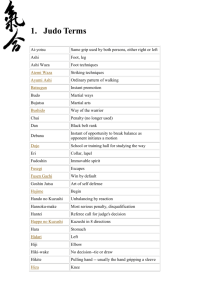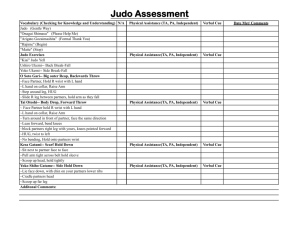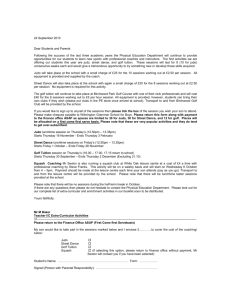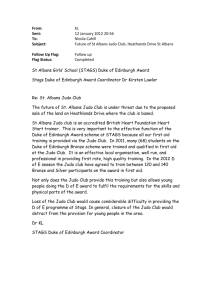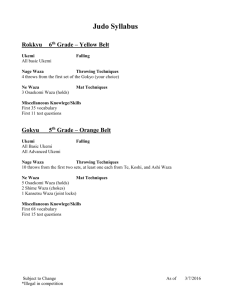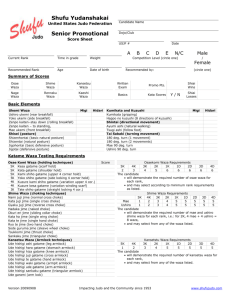USJA Exam for all Senior Judo Ranks with Answers
advertisement
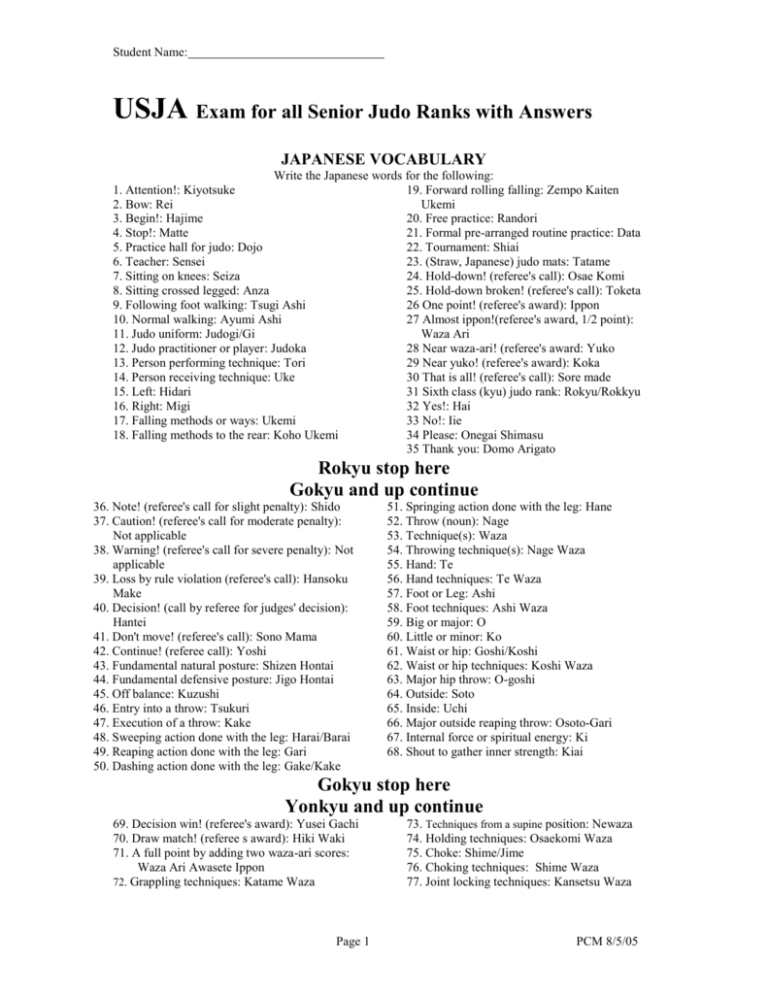
Student Name: USJA Exam for all Senior Judo Ranks with Answers JAPANESE VOCABULARY Write the Japanese words for the following: 1. Attention!: Kiyotsuke 19. Forward rolling falling: Zempo Kaiten 2. Bow: Rei Ukemi 3. Begin!: Hajime 20. Free practice: Randori 4. Stop!: Matte 21. Formal pre-arranged routine practice: Data 5. Practice hall for judo: Dojo 22. Tournament: Shiai 6. Teacher: Sensei 23. (Straw, Japanese) judo mats: Tatame 7. Sitting on knees: Seiza 24. Hold-down! (referee's call): Osae Komi 8. Sitting crossed legged: Anza 25. Hold-down broken! (referee's call): Toketa 9. Following foot walking: Tsugi Ashi 26 One point! (referee's award): Ippon 10. Normal walking: Ayumi Ashi 27 Almost ippon!(referee's award, 1/2 point): 11. Judo uniform: Judogi/Gi Waza Ari 12. Judo practitioner or player: Judoka 28 Near waza-ari! (referee's award: Yuko 13. Person performing technique: Tori 29 Near yuko! (referee's award): Koka 14. Person receiving technique: Uke 30 That is all! (referee's call): Sore made 15. Left: Hidari 31 Sixth class (kyu) judo rank: Rokyu/Rokkyu 16. Right: Migi 32 Yes!: Hai 17. Falling methods or ways: Ukemi 33 No!: Iie 18. Falling methods to the rear: Koho Ukemi 34 Please: Onegai Shimasu 35 Thank you: Domo Arigato Rokyu stop here Gokyu and up continue 36. Note! (referee's call for slight penalty): Shido 37. Caution! (referee's call for moderate penalty): Not applicable 38. Warning! (referee's call for severe penalty): Not applicable 39. Loss by rule violation (referee's call): Hansoku Make 40. Decision! (call by referee for judges' decision): Hantei 41. Don't move! (referee's call): Sono Mama 42. Continue! (referee call): Yoshi 43. Fundamental natural posture: Shizen Hontai 44. Fundamental defensive posture: Jigo Hontai 45. Off balance: Kuzushi 46. Entry into a throw: Tsukuri 47. Execution of a throw: Kake 48. Sweeping action done with the leg: Harai/Barai 49. Reaping action done with the leg: Gari 50. Dashing action done with the leg: Gake/Kake 51. Springing action done with the leg: Hane 52. Throw (noun): Nage 53. Technique(s): Waza 54. Throwing technique(s): Nage Waza 55. Hand: Te 56. Hand techniques: Te Waza 57. Foot or Leg: Ashi 58. Foot techniques: Ashi Waza 59. Big or major: O 60. Little or minor: Ko 61. Waist or hip: Goshi/Koshi 62. Waist or hip techniques: Koshi Waza 63. Major hip throw: O-goshi 64. Outside: Soto 65. Inside: Uchi 66. Major outside reaping throw: Osoto-Gari 67. Internal force or spiritual energy: Ki 68. Shout to gather inner strength: Kiai Gokyu stop here Yonkyu and up continue 69. Decision win! (referee's award): Yusei Gachi 70. Draw match! (referee s award): Hiki Waki 71. A full point by adding two waza-ari scores: Waza Ari Awasete Ippon 72. Grappling techniques: Katame Waza Page 1 73. Techniques from a supine position: Newaza 74. Holding techniques: Osaekomi Waza 75. Choke: Shime/Jime 76. Choking techniques: Shime Waza 77. Joint locking techniques: Kansetsu Waza PCM 8/5/05 Student Name: 78. The principle of gentleness or giving way: Ju 79. Way of life: Do 80. Gentle way: Judo 81. Gentle arts: Jujitsu 82. Favorite technique: Tokui Waza 83. Way of the warrior: Bushido 84. Martial arts: Budo 85. Class of belt ranks in judo below black belt: Kyu 86. Step or degree in the black belt ranks: Dan 87. Holder of any black belt rank: Yudansha 88. Holder of any rank below black belt: Mudansha 89. Black belt association: Yudanshakai_ 90. Repetition attack practice without throwing, done with partner: Uchi Komi 91. Alternate throwing practice without resistance, done with partner: Sute Geiko 92. Solo practice: Tandoku Renshu 93. Practice in pairs: Sotai Renshu 94. Practice in general: Keiko 95. Fourth class (kyu) judo rank: Yonkyu 96. Kneeling bow: Zarei 97. Standing bow: Ritsurei 98. Knee: Hiza 99. Lock or Hold: Gatame 100. Wheel: Guruma 101. Side or lateral: Yoko 102. Fifth class (kyu) judo rank: Gokyu 103. Formal eight directions of off-balancing: Happo No Kuzushi Yonkyu stop here Sankyu and up continue 104. Third class (kyu) judo rank: Sankyu 105. Second class (kyu) judo rank: Nikyu 106. First class (kyu) judo rank: Ikkyu 107. Meditate! (command at close of class): Mokuso 108. Five stages of throwing techniques, the basic syllabus of Kodokan Judo: Gokyu No Waza 109. Newly certified throwing techniques of Kodokan Judo: Shinmesho No Waza 110. Instantaneous promotion: Batsugun 111. Sacrifice: Sutemi 112. Throwing from a standing position: Tachi Waza 113. Throwing techniques done by falling on one's back or side: Sutemi Waza 114. Back falling sacrifice throws: Ma Sutemi Waza 115. Side falling sacrifice throws: Yoko Sutemi Waza 116. Striking techniques to vital areas: Atemi Waza 117. Judo uniform belt: Obi 118. Judo uniform jacket: Uwagi 119. Judo uniform pants: Zubon 120. Judo uniform sleeve: Sode 121. Judo uniform lapel: Eri 122. Illegal act of locking the legs around the torso of an opponent: Dojime 123. Warm-up exercises in judo: Junbi Undo 124. Cooling-off exercises in judo: Shumatsu Undo 125. Exercises in general: Taiso 126. Variation (of a technique): Kuzure 127. Counter technique: Kaeshi Waza 128. . Combination or faking technique: Renwaku Waza 129. Four comers (as in pins): Shiho 130. I surrender! :Maitta 131. Forms of gripping an opponent: Kumi Kata 132. Normal: Naimi 133. Reverse: Gyaku 134. Cross : Juji 135. Arm: Ude 136. Armpit: Wake Sankyu stop here Nikyu and up continue 137. First degree black belt: Shodan 138. Second degree black belt: Nidan 139. Third degree black belt: Sandan 140. Fourth degree black belt: Yodan/Yondan 141. Fifth degree black belt: Godan 142. Sixth degree black belt: Rokudan 143. Seventh degree black belt: Shichidan 144. Eighth degree black belt: Hachidan 145. Ninth degree black belt: Kudan 146. Tenth degree black belt: Judan Page 2 147. Twelfth degree black belt (held only by Dr. Kano): Junidan 148. Loss of any type: Make 149. Win of any type: Gachi/Kachi 150. Win by forfeit or default of the opponent before a match: Fusen Gachi 151. Win by withdrawal of the opponent during a match: Kiken Gachi PCM 8/5/05 Student Name: 152. Combination win by adding a one half point from a violation and one waza-ari: Sogo Gachi 153. Slight superiority (contest call): Kinsa 154. Side of the dojo or tournament mat reserved for senior judoka or officials: Joseki 155. Cross arm lock: Juji-gatame 156. Entangle: Garami 157. Formal forms of throwing: Nage-No-Kata 158. Formal forms of grappling: Katame-NoKata 159. Formal forms of gentleness: Ju-No-Kata 160. Formal forms of self-defense: GoshinjitsuNo-Kata 161. Formal forms of decision: Kimi-No-Kata 162. Ancient forms: Koshiki-No-Kata 163. Forms of five: Itsutsu-No-Kata 164. Past master of judo (title traditionally applied only to Dr. Kano): Shihan Nikyu stop here Ikkyu and up continue 165. Mutual benefit & welfare: Jita Kyoei 166. Maximum efficiency: Seiroyku Zenyo 167. "Winner stays up" team contest: Kohaku Shiai 168. Man-for-man, or elimination tournament: Tentori Shiai 169. Methods of resuscitation used in judo: Katsu/Kappo 170. Illegal act of entwining the leg of an opponent: Kawazu Gake 171. Contest area: Shiaijo 172. Referee: Shimpan 173. To float or floating: Uki 174. Lift: Tsuri 175. Pull: Komi 176. Lift-pull action: Tsurikomi 177. Defense (to an attack): Bogyo 178. Escape (as from a pin): Fusegi 179. Entry methods into matwork: Hairi Kata 180. Body: Tai 181. Thigh: Mata 182. Rear, behind (as in throwing and pinning): Ushiro 183. Reverse side, back: Ura 184. Pivoting or turning the body: Tai Sabaki 185. Single handed: Katate 186. Double handed: Ryote 187. Both hands: Moryote/Morote 188. Avoiding or evasive action: Sukashi 189. A little: Sukoshi 190. Same side gripping (right vs right, left vs left): Ai Yotsu 191. Opposite side gripping (right vs left): Kenka Yotsu 192. Pulling or locking hand (usually sleeve hand): Hikite 193. Power or drawing hand (usually lapel hand): Tsurite 194. Red (used to differentiate players in a match): Aka 195. White (used to differentiate players In a match): Shiro 196. Time! (referee's call): Jikan 197. Decision or decisiveness (as in thinking fast): Kime 198. To drop: Otoshi Ikkyu stop here Shodan and above stop here GENERAL INFORMATION Write the answers for the following: 1. What is the name of your club?_______________________________________ 2. Name of Instructor? ______________________________ 3. What is the name of your judo organization? USJA – United States Judo Association 4. Who was the founder of judo? Dr. Jigoro Kano 5. What is the name of the school he founded? The Kodokan 6. What is the date of the founding of Kodokan Judo? 1882 7. What was unarmed combat called in Japan before judo? Jujitsu 8. How long had unarmed combat martial arts been practiced in Japan? About 600 to 1000 years 9. Name the three parts of unarmed combat in 1. Throwing Techniques / Nage Waza Page 3 PCM 8/5/05 Student Name: 2. Grappling Techniques / Katami Waza 3. Striking Techniques / Atemi Waza 10. Name the three parts of a judo throw in English and Japanese. 1. Off-balance / Kuzushi 2. Entry / Tsukuri 3. Completion / Kake 11. List the belt ranks in order by color: White, Yellow, Orange, Green, Brown, Black Rokyu stop here Gokyu and up continue 12. .Name the two divisions of throwing techniques in English and Japanese. 1. Standing Techniques / Tachi Waza 2. Sacrificing Techniques / Sutemi Waza 13. Name the three divisions of standing throwing techniques in English and Japanese. 1. Hand Techniques / Te Waza 2. Hip Techniques / Koshi Waza 3. Foot & Leg Techniques / Ashi Waza 14. Name the two divisions of sacrifice throwing techniques in English and Japanese. 1. Back Sacrificing Techniques / Ma Sutemi Waza 2. Side Sacrificing Techniques / Yoko Sutemi Waza 15. What are the ordinal numbers between one and ten in Japanese? 1. Ichi 6. Roku 2. Ni 7. Shichi 3. San 8. Hachi 4. Shi 9. Ku 5. Go 10. Ju Gokyu stop here Yonkyu and up continue 16. Name the three divisions of mat techniques in English and Japanese. 1. Holding Techniques / Osaikomi Waza 2. Strangulation Techniques / Shime Waza 3. Joint Lock Techniques / Kansetsu Waza 17. Name three of the eight men who attained 10th degree black belt (Judan) in judo while they were still alive. Yoshiaki Yamashita – 1935 Hidekazu Nagaoka – 1937 Hajime Isogai – 1937 Kyuzo Mifune – 1945 Kunisaburo Iizuka – 1948 Shotara Tabata – 1948 Sumiyuki Kotani - 1984 18. What are the two principles of Kodokan Judo as defined by Dr. Kano? Mutual benefit and welfare – Jita Kyoei Maximum efficiency – Seiroyku Zenyo 19. What is the ultimate goal of judo as defined by Dr. Kano? The harmonious development and eventual perfection of the human character 20. What does the acronym G.E.T. P.A.D. (tactical variables for randori/shiai) stand for? Grip Tempo Angle of attack Edge of mat Posture Direction of movement Yonkyu stop here Sankyu and up continue 21. What year was judo first introduced into the summer Olympic games? 1964 22. Who were the four men on the first U.S. Olympic judo team? Page 4 PCM 8/5/05 Student Name: Ben Campbell, Jim Bregman, George Harris, Paul Maruyama 23. Which American placed the first time judo was included at the Olympics, and what place did he win? Jim Bregman - Bronze 24. Name the six kyu ranks and colored belts from highest to lowest rank (do not list White Belt): 1. Brown – Ikkyu 4. Green – Yonkyu 2. Brown – Nikyu 5. Orange – Gokyu 3. Brown – Sankyu 6. Yellow - Rokyu 25. Name (Japanese Name) the 10 black belt ranks in order: 1. Shodan 6. Rokudan 2. Nidan 7. Shichidan 3. Sandan 8. Hachidan 4. Yodan 9. Kudan 5. Godan 10. Judan 26. What does the word "JUDO" mean in English? The Gentle Way Sankyu stop here Nikyu and up continue 27. What other colored belt are some black belt persons entitled to wear? 1st Degree - Black 6th Degree – Red & White Panel 2nd Degree - Black 7th Degree - Red & White Panel 3rd Degree - Black 8th Degree - Red & White Panel 4th Degree – Black & Red Panel 9th Degree - Red 5th Degree - Black & Red Panel 10th Degree - Red 28. What are the four sides of the dojo called? (Refer to diagram below) 1. Upper Seat / Kamiza 2. Upper Side / Joseki 3. Lower Seat / Shimoza 4. Lower Side / Shimoseki_ Side 1 ╔═══ ═══ ═══ ══ ════ ═══ ═╗ ║ Instructors ║ ║ ║ Side 2 Side 4║ ║ ║ ║ ║ Students ║ ╚═══ ═══ ═══ ══ ════ ═══ ═╝ Side 3 29. Which American was the first to win a medal at the World Championships in judo and what place did he win? James Bregman – Bronze 1965 30. List the nine kata of Kodokan Judo in English and Japanese. 1. Nage-No-Kata / Forms of throwing 2. Katame-No-Kata / Forms of Grappling 3. Ju-No-Kata / Forms of gentleness 4. Goshinjitsu-No-Kata / Forms of self-defense 5. Kimi-No-Kata / Forms of decision 6. Joshi-Goshinho / Forms of self-defense for women 7. Itsutsu-No-Kata / Forms of five 8. Koshiki-No-Kata / Ancient forms or Forms of Antiquity 9. Seiryoko-Aenyo-Kokuimin-Taiiku / Maximum Efficiency Physical Fitness Page 5 PCM 8/5/05 Student Name: Nikyu stop here Ikkyu and up continue 31. Name four Americans who have won medals at the Olympic Games in judo, and what place they won. 1. James Bregman – Bronze in 1964 2. Allen Coage – Bronze in 1976 3. Jason Morris – Silver in 1992 4. Jimmy Pedro – Bronze in 1996 and 2004 32. Which American was the first to win a gold medal at the Men's World Games in judo? Michael Swain 1987 33. Which American was the first to win a gold medal at the Women's World Games in judo? Ann Marie Burns 1984 34. What year was women's judo first introduced into the summer Olympic games as a full medal event? 1992 (Demo event in 1988) 35. What are the ordinal numbers between eleven and twenty in Japanese? 11. Ju ichi 16. Ju roku 12. Ju ni 17. Ju nana/Ju shichi 13. Ju san 18. Ju hachi 14. Ju shi/Ju yon 19. Ju kyu 15. Ju go 20. Niju Ikkyu stop here Shodan and up continue ESSAY QUESTIONS Answer the following: 36. What has judo done for you? 37. What have you done for judo? Shodan and above stop here Page 6 PCM 8/5/05 Student Name: Page 7 PCM 8/5/05 Student Name: Page 8 PCM 8/5/05 Student Name: Page 9 PCM 8/5/05 Student Name: Page 10 PCM 8/5/05 Student Name: Page 11 PCM 8/5/05 Student Name: Page 12 PCM 8/5/05 Student Name: Page 13 PCM 8/5/05 Student Name: Page 14 PCM 8/5/05 Student Name: Page 15 PCM 8/5/05 Student Name: Page 16 PCM 8/5/05

